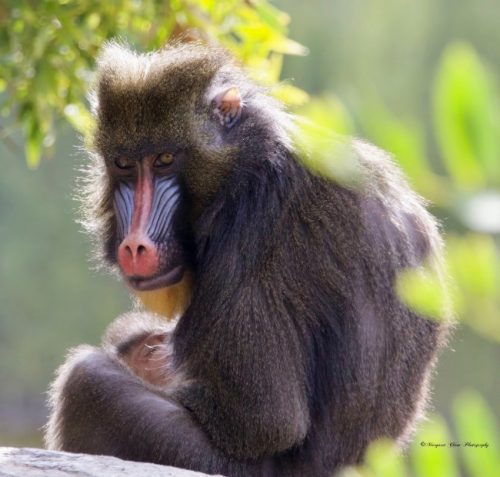
LuLu, a 20-year-old female mandrill, holds on to the male infant she gave birth to on Feb.1, 2023. Mandrills are the world’s largest monkey, found in the subtropical forests of southwest Cameroon, western Gabon, Equatorial Guinea and southwest Congo. (Photo: Margaret Chow)
by Janis Mara –
Quite possibly the cutest baby born in San Francisco this month, with huge brown eyes and big ears, is currently in residence at the San Francisco Zoo.
The as-yet-unnamed baby mandrill arrived February 1, presumably to the delight of his parents, longtime zoo residents Lulu and Big Joe.
“We are thrilled with this latest birth, as mandrills are considered a vulnerable species in the wild,” said Tanya Peterson, CEO of San Francisco Zoological Society, no doubt speaking for Lulu and Big Joe.
With a bright crimson streak flanked by blue stripes down her nose, somewhat similar to Mel Gibson’s face paint in the movie “Braveheart,” Mama Lulu’s appearance is typical of mandrills. In addition to their noses, mandrills’, er, hindquarters also are brightly colored, from pink to deep vermillion. Sir Mix-A-Lot, take notice!
However, baby mandrills don’t arrive with the distinctive coloring, so it will take the zoo’s littlest mandrill some time to catch up with his parents.
He is presently riding around on his mother’s belly, zoo officials said. Baby mandrills do this by clutching their mothers’ fur – no baby sling necessary.
Apparently, Lulu and Big Joe spend a fair amount of time monkeying around; the 20-year-old mom and her 12-year-old mate have two other children, Kiburi and Benny, according to zoo officials.
The zoo has two other mandrills, Pandora and Angie, sisters who are not related to Lulu and Big Joe.
Mandrills are the world’s largest monkey, the zoo tells us. They are related to white-eyelid mangabeys, according to Wikipedia, which suggests that one of the world’s most distinctively colored mammals is linked with one of the world’s most distinctively named critters.
Further research reveals that white-eyelid mangabeys have white eyelids, which probably shouldn’t be too surprising, all things considered. These monkeys have long muzzles somewhat reminiscent of the mandrills’, but they’re black, not multicolored.
On a more serious note, “It’s important for us to share the story of this charismatic primate species, whose populations have seen a 30% decline over the past 30 years, and what better way than to highlight great news, like this rare birth,” Peterson said in a statement.
Neither of the new arrival’s two siblings, Kiburi and Benny, were available for comment.
